NBA DFS Guide: Covering the Basics, Contest Selection, Bankroll Management, and More
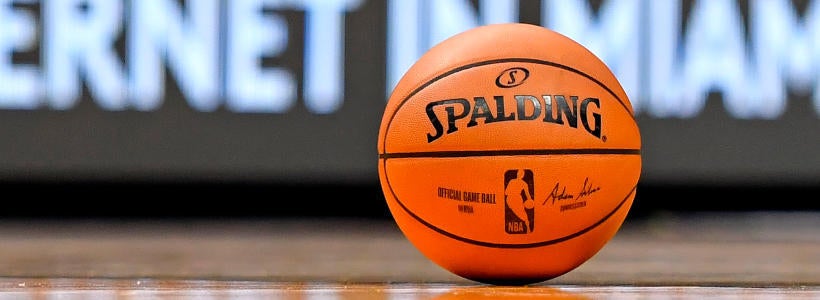
If you have been around DFS circles for long, I'm sure you've heard terms like "cash games," "tournaments," "GPPs," "ceiling/floor," "chalky," or "hitting value," tossed around as if they're common phrase. I am guilty too. I regularly use phrases like these in my work, as if they're a part of every readers' vernacular.
Fortunately, I've had several SportsLine users ask me for clarification on the meaning of different phrases, the differences in contest types, and what types of strategies should be employed in each. I do my best to answer each question and be accessible to help anyone who needs it, but that only goes so far.
Ultimately, I want to help our SportsLine users become better DFS players. Obviously, I hope that any time you use my player pool or play a lineup that I constructed, you win money that day. But, the hope is that by reading my work on SportsLine and following along on Twitter, you become a better DFS player and become confident in doing your own research, making your own lineups, and knowing what type of contests to enter them in. With the way the major sites have upped the rake these days, if you want to be a consistently profitable player, you not only have to be a proficient lineup builder, but you have to be intentional about your contest selection. So, I'm going to first familiarize you with some of the most common phrases used in NBA DFS, and then we'll tackle the all-important topic of contest selection. If you're a seasoned vet, go ahead and skip to the bottom, where you will find the most value in this article.
Cash Games vs. Tournaments
Alright, let's start by defining cash games and tournaments. You'll hear both phrases used in almost any article or podcast, and understanding the difference is a key component to success in DFS.
Cash games most often refer to double-ups, 50/50's, and head-to-head (H2H) contests. Cash games are more low risk/reward contests, where you generally have to beat one other player or beat half of the field to double your money. You probably could have guessed that H2H's are you vs. one other player, while double-ups and 50/50's are similar but differ slightly. Double-ups give you exactly double your entry fee, while the "rake," or the amount of money that the site takes from your entry is factored into the payout pool. Instead of paying out exactly the top half, double-ups generally reward the top 43-to-44%. 50/50's are slightly less risky, paying out the top 50% but only rewarding 90% of your entry. So, if you win in a $1 50/50, you will be rewarded $1.80, whereas you'd make an even $2 in a double-up. H2H's also pay out 90%, unless you are playing on a site with rake-free H2H's, like FantasyDraft.
Tournaments, which are also often referred to as "GPPs," or guaranteed prize pools, are far more high risk/reward contests. Generally speaking, these contests pay out the top 17-to-27% of the field, with the minimum cash payout being somewhere around 1.5-to-2 times your entry fee. In these contests, there is far more game theory involved, which we will cover in more detail later in the article.
There are many other types of contests that you can enter, including different types of "multipliers" and "satellites." The most common multipliers include triple-ups, quintuple-ups, and 10x boosters, which all function as you would expect. In triple-ups, the top-third of the field gets three-times their entry fee back, and so on.
Satellites are contests with super top-heavy payout structures, varying anywhere from the top-10% to only first place winning. In these contests, the prizes often aren't straight cash, but rather a ticket to play in a larger tournament of some sort. Generally speaking, satellites are low-to-negative EV (expected value) contests.
Ownership Percentage
Another relevant aspect of DFS is player ownership percentage. You will hear it referenced frequently, in many different forms. Ownership is used to reference the percentage of the field in a given contest that rostered a certain player. When a player's game starts, you should see a percentage next to their name, which lets you know how popular of a play he was that day. Ownership ties in heavily to game theory, which, again, we will talk about later. For now, let's cover some of the common ownership-related phrases.
Chalky -- If a player is anticipated to be a super popular play on a given night, you'll likely hear them referred to as a "chalky" play. "The chalk" just refers to the players who are expected to be the most highly-owned on any given night.
Fade -- "Fading the chalk" is a common phrase that simply refers to avoiding the most-common players on that slate of games. It also can be used to reference avoiding an entire game. You might hear me say "I'm fading the Warriors game, as I'm expecting a blowout."
Contrarian -- This simply refers to a player who is expected to not be rostered at a high rate that night. It varies depending on the amount of games on a slate, but generally speaking, any player under 10% owned is considered contrarian.
Pivot -- A pivot differs slightly from a contrarian play, as a pivot is used in direct correlation to a more popular play -- most commonly, a popular player within the same price range and/or position. So, Gordon Hayward might be expected to be only three percent owned, but he isn't a pivot off a chalky Russell Westbrook, who costs $2,000 more and plays a different position. Instead, a pivot off of a chalky Westbrook might be Damian Lillard in a potential blowout or a matchup that is perceived to be difficult.
Leverage -- Leverage plays are similar to pivots, as they pertain to a specific popular play, but there is a slight difference. Most commonly, leverage plays are an if-then situation, while pivots are simply taking a lower-owned player at the same price/position strictly for the sake of ownership. For example, if Andre Drummond is expected to be a chalky play against the Clippers, but you anticipate that the game may blowout, someone like his teammate Christian Wood would be an excellent leverage play. You are playing Wood with the hopes that Drummond plays limited minutes due to foul trouble or blowout, while Wood gets to pile up fantasy points in garbage time. Wood wouldn't qualify as a pivot, as he isn't in the same price tier, but he certainly qualifies as a leverage play.
"Hitting Value"
You'll hear me frequently reference "hitting value," which refers to a player scoring five-times their salary-implied point total. It is really that basic. If a player is priced at $10,000, "five-times" value at that price would be 50 (10.0 x 5 = 50). A player at $6,900 would need 34.5 points to "hit value" (6.9 x 5 = 34.5).
When we reference hitting value, it almost always means 5x, which is the most accepted expected value for cash games. That would mean that if you use your full $50,000 salary on DK, you are expecting 250 points from your roster. Generally speaking, hitting 5x is going to give you a shot at cashing in double-ups and H2H. I try to shoot for about 5.5x value for cash games and 6.5x value for tournaments with scores seeming to be higher these days. So, now you know that when you hear someone say "LeBron needs 55 to hit value at his price tag," that is because he has an $11,000 price tag.
Ceiling and Floors
The terms "ceiling" and "floor" are used commonly in reference to a player's statistical ceiling or floor. Dudes like LeBron, James Harden, or Giannis Antetokounmpo have an incredibly high built-in floor, due to elite usage and the ability to contribute in several different categories. However, a superstar like D'Angelo Russell has a much lower floor. Russell's Warriors are often involved in blowouts, and he gets a higher percentage of his fantasy points from real-life points, so he is somewhat dependent on his shot falling.
For cash games, you are going to want to target players with more secure floors. Factors like potential blowouts, a player's usage rate, and a player's propensity to get into foul trouble are key in identifying low floors and potential cash game landmines. Sometimes you can't anticipate random blowouts or foul trouble spots, but if you're repeatedly rostering a foul-prone player like Jaren Jackson Jr. or players tasked with defending dudes notorious for drawing fouls like James Harden or Joel Embiid, you might want to rethink your cash game strategy.
Punt Plays and Stars n' Scrubs
A punt play refers to a value that allows you to fit in the Joel Embiid's and Nikola Jokic's of the world. You'll hear this phrase used frequently when referring to a fill-in player who is near minimum salary. "Stars n' scrubs" is another common saying that simply refers to a roster construction built around several punt plays and stud players. Generally speaking, this type of roster construction is more risky and better suited for tournament play. Differentiating between good and bad punt plays is a huge part of sustained success in NBA DFS.
Bankroll Management
Bankroll management is up there with contest selection as one of the most overlooked aspects for first-time DFS players. If you are just playing casually, then you probably don't need to stress yourself out tracking your bankroll. But, if you are trying to play for a full season and maintain any type of profitability, I highly recommend monitoring your bankroll.
The term "bankroll" itself is often misunderstood, in reference to DFS. Your bankroll isn't the amount of money you have deposited on DraftKings, or the amount of money you enter on a given night, but rather the amount of money that you are comfortable dedicating to a "DFS season." So, essentially, it is whatever amount of money you are okay with losing in a given season. Maybe that number is $25 for you, or maybe it is $25,000. Either way, you need to manage what percentage of that money you use on a nightly basis, or you could end up losing it all in one week.
How risky you want to be with your bankroll is totally up to you, but for reference, here is how I handle mine. The maximum amount of money that I put in on any given slate is 12.5% of my bankroll. And the only way I ever enter that much is if I am playing 100% cash games, with a priority on H2H to mitigate the risk. The table below displays what percentage of my bankroll I enter on a given day, which is dependent on the type of contests I am entering that day.
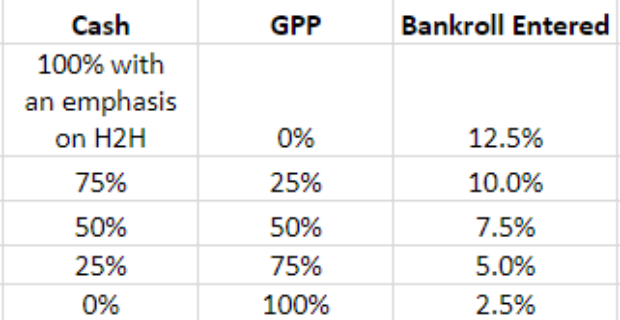
As you can see, it is actually quite simple. If you follow that, or your own modified form of some sort, you're well on your way to a long and (hopefully) profitable DFS season.
Personally, I start at a set amount of money and add/subtract based on how much I profit each night. So, if I start at $10 on a Monday and lose $1 the first night, my bankroll the following night would be $9. If I profited $11 that Tuesday, my updated bankroll on Wednesday would be $20, so I'd enter around $2 that Wednesday.
Contest Selection
Now that you know all of the basics and have an understanding of how to responsibly manage your bankroll, it's time to dive into the all-important contest selection.
Single-Entry vs. Mass Multi-Entry (MME)
If examining contests in the DraftKings lobby, you'll notice that some are labeled "single-entry" or "3 entry max." We'll start by focusing on single-entry, specifically from a cash game perspective. When searching for double-ups, I almost exclusively enter single-entry contests. I'm not a heavy double-up player, traditionally around 70% of my cash game action comes from H2H contests. So, it is easy for me to focus solely on single-entry contests, which I believe to be a higher EV contest type than MME double-ups.
When entering contests, focus on single-entry. If playing on DraftKings, you can simply type "single entry" into the search bar.
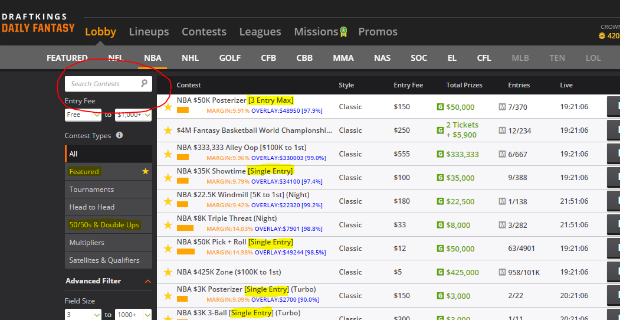
From a tournament perspective, you will notice that as a general rule, single-entry or three-entry max contests aren't going to have the same type of huge payouts that MME contests do. That is fine. I don't blame you if you want to throw darts at MME contests, but I stay far away from them. The rake is traditionally higher in these huge contests, and the payout structure is far too top-heavy for consistent profitability.
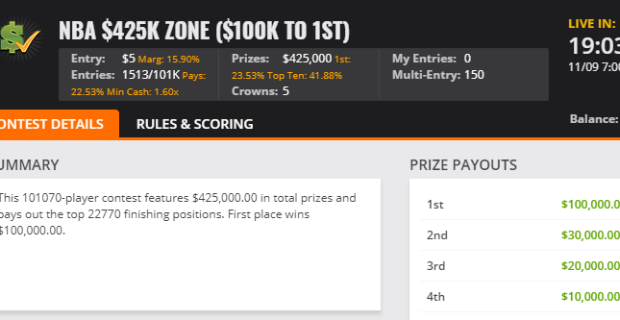
This MME contest may seem appealing -- the idea of turning $5 into $100,000 is of course alluring. However, you will notice that a whopping 23.5% of the prizes go to first place, while 41.88 percent goes to the top-10. That's right, 42 percent of the payout goes to the top 0.009 percent of the field. Even as an elite tournament player, you could go several seasons without finishing inside the top 0.009 percent of a 101,070 person tournament. For reference, your chances of getting struck by lightning in your life are 3.7 times more likely than finishing inside the top-10 of that tournament. As a result of this ridiculously top-heavy payout structure, you have to be in the top seven percent to even double your entry fee. To make 5x your entry fee, you have to finish inside the top 0.54%.
For comparison, you can 5x your entry fee in the single-entry $12 "pick + roll" by finishing in the top 1.4% of the 4,901 person field. The top 11.2% double their entry fee. This contest also pays out 26.3% of the field, as opposed to the MME contest that paid out 22.5%.
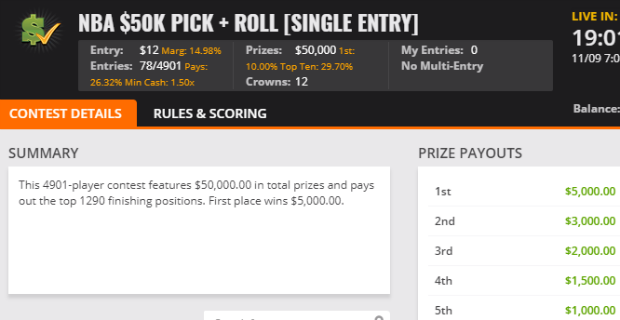
I also would highly recommend downloading RotoGrinders' DraftKings Extension, which is free and extremely helpful when working on contest selection. That is what shows me the percentage breakdown of payout that is displayed in these images.
How To Handle H2H
I often get questions about which specific contest types are best for cash games -- head-to-heads or double-ups. In the past, I have been a more double-up heavy player, but as rake continues to go up and the field continues to become more informed, I've found myself leaning more heavily towards the lower risk/reward option of the two -- head-to-heads.
Obviously, on good nights, you love to see your money get straight-up doubled in cash games. If your cash game lineup is consistently dropping 275-to-300 points a night, then just enter double-ups and win all the money. Realistically though, with a DFS season as long as NBA, there are going to be ebbs and flows as the year goes on. Head-to-heads help hedge against the inevitability of off nights, by at least returning some of your money to you if you don't quite make the cut in double-ups.
Generally speaking, about 70% of my bankroll entered in cash games is H2H, while the remaining 30% is double-ups or 50/50's. I would recommend somewhere in the 50-to-75% range for you.
One important note for H2H's is to always create your own. More often than not, the players who post H2H's are top-end players, while those who scoop others' H2H's are not. If you've never created a contest on DK before, it is actually quite simple.
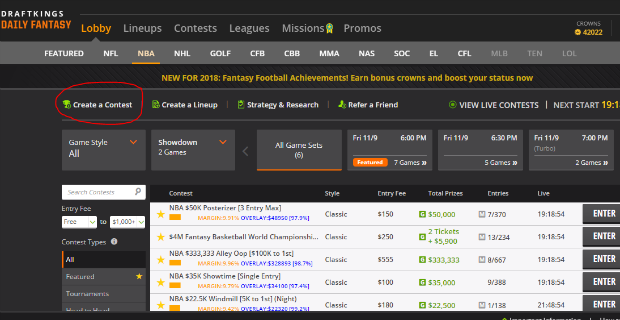
Begin by clicking "Create a Contest" in the DK Lobby. Then click "NBA," "Classic," and the upcoming main slate, which should be the first available option. Next, click head-to-head, and it should bring you to this screen.
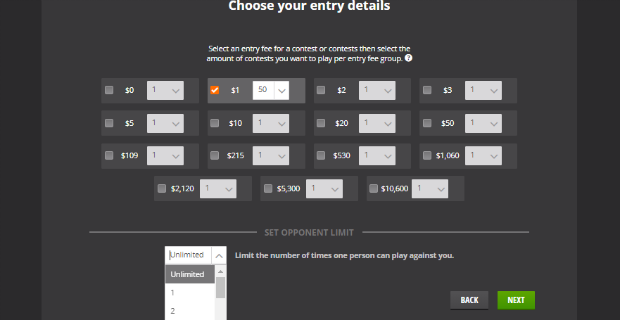
From here, you can choose how many H2H contests you create and what buy-in level you create them at. An often overlooked option here is the "Opponent limit," which allows you to prevent opponents from scooping multiple H2H's against you. One person scooping multiple H2H's essentially defeats the purpose of playing H2H's in the first place, which is to diversify your cash game action. I normally set my limit at one or two.
Try to create your H2H's with plenty of time for other players to find and join them prior to lock. If you have H2H's that are unaccounted for at lineup lock, DraftKings will auto-match you with other players who have unaccounted for H2H's. That isn't the end of the world, but it does defeat the purpose of posting your own H2H's. If you are especially averse to playing against top-level players, you can manually cancel your unaccounted for H2H's prior to lock to avoid being matched with potentially professional DFS players.
Takeaways
Monitoring your bankroll and the types of contests you enter isn't as exciting as putting together a tournament lineup loaded with #TeamGameTheory plays, but it is every bit as important. If DFS is just a hobby that you play for fun, I wouldn't worry about putting this much thought into your play. But, if you are hoping to sustain long-term success in today's DFS environment, some level of intentionality is required.
If you have any unanswered questions after reading, hit me up on Twitter: @Jagibbs_23.

Share This Story



